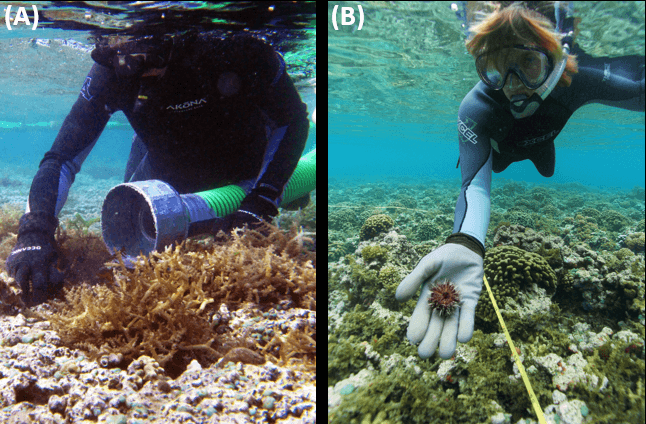Native sea urchins help clear invasive macroalgae from Oahu reef, study finds

COURTESY DLNR/DAR
Divers used the Super Sucker, left, and outplanted sea urchins.
A University of Hawaii at Manoa study Opens in a new tab has found that native sea urchins can successfully reduce the invasive, reef-smothering macroalgae by 85 percent on a coral reef at Kaneohe Bay on Oahu.
Chris Opens in a new tabWall Opens in a new tab, a doctoral candidate at the university’s Hawaii Institute of Marine Biology and state Division of Aquatic Resources acting administrator Brian Neilson, were part of a team that combined the outplanting of the sea urchins with manual removal to test the novel management approach.
“This management approach is the first of its kind at the reef-scale,” said Wall in a news release. “Our research shows promise as an effective means to reduce invasive macroalgae with minimal environmental impact, while also incorporating a native herbivore to regulate a noxious invasive species.”
Globally, the health of coral reefs is threatened due to rising ocean temperatures and ocean acidification. In Hawaii, the invasive macroalgae poses yet another serious risk by smothering native coral. Unfortunately, there are often limited options for reducing invasive macroalgae without causing further environmental damage.
For the two-year project, divers manually removed more than 40,000 pounds of invasive macroalgae using an underwater vacuum system called “The Super Sucker” on nearly six acres of reef at Kaneohe Bay. To control regrowth, the team then outplanted 99,000 juvenile sea urchins (Tripneustes gratilla), which were raised at a hatchery, to graze on invasive algae.
During this period, invasive macroalgae declined in response to treatments, according to researchers, and more importantly, no negative effects to important reef calcifiers such as corals and crustose coralline algae were observed.
Don't miss out on what's happening!
Stay in touch with breaking news, as it happens, conveniently in your email inbox. It's FREE!
Prior to this study, scientists had found the manual removal/urchin herbivory method worked at reducing invasive macroalgae in a laboratory as well as in small enclosures on the reef.




